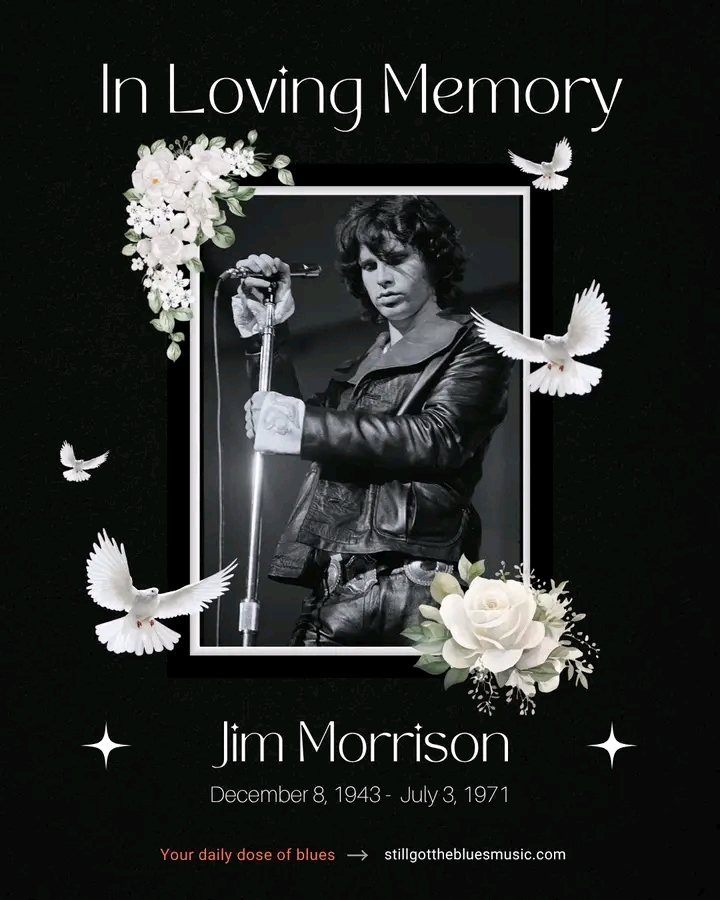Jim Morrison, the mercurial poet‑frontman of The Doors, remains an enduring icon of 1960s rock. Born James Douglas Morrison in Melbourne, Florida, his early life was shaped by frequent relocations as the son of naval aviator Rear Admiral George Morrison and homemaker Clara Clarke Morrison. A formative childhood incident—witnessing a tragic truck accident in New Mexico—left a deep impression on his psyche, fostering introspection and fascination with mortality .

After graduating high school in Alexandria, Virginia, Morrison briefly attended junior college and Florida State University before enrolling at UCLA’s prestigious film school in 1964. It was here that he met Ray Manzarek, forming a partnership that would birth The Doors . Morrison’s time at UCLA was transformative—immersing himself in avant‑garde, surrealist theater through Jack Hirschman’s Antonin Artaud class and exploring psychedelics, philosophy, and crowd psychology. Though he completed his degree in 1965, he felt deeply misunderstood by peers, prompting a pivot toward music .
The Doors officially formed in 1965 with guitarist Robby Krieger and drummer John Densmore, quickly securing a contract with Elektra Records. Their 1967 self‑titled debut featured the chart‑topping single “Light My Fire,” propelling them to nationwide fame. Between 1967 and 1971, the band released six influential albums—including Strange Days, Waiting for the Sun, Morrison Hotel, and L.A. Woman. Morrison’s hypnotic vocals and poetic lyrics, informed by blues, psychedelia, and existential literature, defined their unique sound .
As a performer, Morrison was legendary—his stage presence centering on the mythic persona “The Lizard King.” He captivated audiences with shamanic flair and raw energy. Contemporary reviews noted how his voice “grabs your lapels” and sent fans spiraling into ecstatic states . His songwriting blended cinematic storytelling with literary allusions, referencing figures like Rimbaud and Kerouac, and drawing upon mythology and psychoanalysis .
Parallel to his music career, Morrison explored poetry and film. His 1969 experimental featurette, HWY: An American Pastoral, showcased his interest in the hitchhiker archetype and cinematic form—though the film remains largely unreleased outside bootleg circles . Critics and scholars later recognized his lyrical records—like The American Night—as groundbreaking in melding poetry with rock idioms .
In early 1971, following unrest from his 1969 Miami arrest, Morrison relocated to Paris with partner Pamela Courson. On July 3, 1971, he was found dead in the bathtub of their Marais apartment. The official cause was heart failure, attributed to heavy drinking—but no autopsy was performed, giving rise to enduring speculation and conspiracy . His grave at Père‑Lachaise became a pilgrimage site, drawing fans who left flowers, graffiti, and whiskey to honor him. In 1981, a marble bust by Mladen Mikulin was placed at his gravesite, only to be stolen in 1988—recently recovered by French police during a fraud investigation .
Though Morrison passed at just 27, his influence remains powerful. He reshaped what it meant to be a rock frontman—as poet, provocateur, and philosopher. His boundary‑pushing artistry continues to inspire musicians, writers, and filmmakers. Today, an annual gathering marks his death anniversary; in May 2025, bridges and public spaces in Paris were even named in his honor—cementing his global legacy .
🕊️ Legacy in Reflection
Jim Morrison once mused, “Whoever controls the media, the images, controls the culture.” Through his haunting voice, fragmented poetry, and rebel mystique, Morrison opened doors—leaving indelible imprints on rock, film, and literature. His legend endures, an open invitation to confront the unknown and transcend convention.
Key Dates:
Born: December 8, 1943, Melbourne, Florida
UCLA Graduation: June 1965 (received diploma by mail)
Formed The Doors: 1965
Debut Album & “Light My Fire”: January 1967
Died: July 3, 1971, Paris
Interred: July 7, 1971, Père‑Lachaise Cemetery
